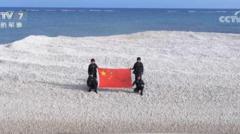In a provocative turn of events, the Chinese coastguard has asserted control over a small sandbank in the South China Sea, reported by state media as an escalation in an ongoing regional conflict with the Philippines. Broadcast images from CCTV showcased four coastguard officers donning black uniforms while holding the Chinese flag at Sandy Cay, a contentious reef within the Spratly Islands. The broadcaster announced that China had executed "maritime control and exercised sovereign jurisdiction" over the area as early as April.
The Philippine government has yet to issue an official response. Both nations have long-standing claims on various islands and maritime zones, leading to increasing confrontations characterized by vessel collisions and physical skirmishes. Sandy Cay is strategically located near Thitu Island, where the Philippines reportedly maintains a military outpost to monitor Chinese movements.
Recent reports indicate that there is currently no permanent Chinese occupation of the 200-square-meter sandbank, with the coastguard reportedly having vacated the area. However, the U.S. administration expressed concern over China's latest actions. James Hewitt, spokesperson for the U.S. National Security Council, emphasized that "such actions threaten regional stability and violate international law," noting that the White House is in close consultation with its allies regarding the situation.
This move follows the conduct of the annual Balikatan exercises, a military collaboration between U.S. and Philippine forces, with around 17,000 personnel participating in war drills designed for national defense. The exercises have recently been criticized by China, being framed as provocative. This year's operations have seen U.S. marine defense systems, including missile tests conducted off the northern Philippines coast.
Philippine military officials maintain that their training exercises aim to fortify national defense, asserting that they are not targeted at any specific nation. This type of military engagement has reportedly alleviated concerns among U.S. allies regarding potential changes in American military support following recent political shifts stateside. During a visit to Manila last month, U.S. Defense Secretary Pete Hegseth reaffirmed Washington's commitment to the alliance, vowing to strengthen deterrence against Chinese aggression.
Historical disputes over territory in the South China Sea have intensified in recent years, particularly as China stakes expansive claims demarcated by its controversial "nine-dash line," which encompasses vast areas of the sea and extends from Hainan province. The tensions are further complicated by multiple claimants, including Vietnam, Taiwan, Malaysia, and Brunei, each asserting rights to various islands and maritime zones.


















